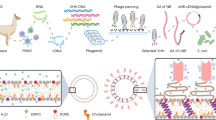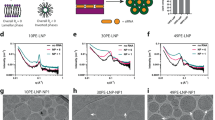Abstract
We describe the assembly of a cationic lipid-nucleic acid nanoparticle from a liquid monophase containing water and a water miscible organic solvent where both lipid and DNA components are separately soluble prior to their combination. Upon removal of the organic solvent, stable and homogenously sized (70–100 nm) lipid-nucleic acid nanoparticles (Genospheres™) were formed. The low accessibility (<15%) of the nanoparticle-encapsulated DNA to a DNA intercalating dye indicated well-protected nucleic acids and high DNA incorporation efficiencies. It was demonstrated that Genospheres could be stably stored under a variety of conditions including a lyophilized state where no appreciable increase in particle size or DNA accessibility was observed following reconstitution. Finally, Genospheres were made target-specific by insertion of an antibody-lipopolymer (anti-HER2 scFv (F5)-PEG-DSPE) conjugate into the particle. The target specificity (>100-fold) in HER2 overexpressing SK-BR-3 breast cancer cells was dependent on the degree of PEGylation, where the incorporation of high amounts of PEG-lipid on the particle surface (up to 5 mol%) had only a minor effect on the transfection activity of the targeted Genospheres. In summary, this work describes a novel, readily scalable method for preparing highly stable immunotargeted nucleic acid delivery vehicles capable of achieving a high degree of specific transfection activity.
This is a preview of subscription content, access via your institution
Access options
Subscribe to this journal
Receive 12 print issues and online access
$259.00 per year
only $21.58 per issue
Buy this article
- Purchase on Springer Link
- Instant access to full article PDF
Prices may be subject to local taxes which are calculated during checkout



Similar content being viewed by others
References
Felgner PL, Gadek TR, Holm M, Roman R, Chan RW, Wenz M et al. Lipofectin: a highly efficient, lipid-mediated DNA-transfection procedure. Proc Natl Acad Sci USA 1987; 84: 7413–7417.
Wiley-InterScience. www.wiley.co.uk/genetherapy/clinical.
Chesnoy S, Huang L . Structure and function of lipid-DNA complexes for gene delivery. Annu Rev Biophys Biomol Struct 2000; 29: 27–47.
Barron LG, Gagne L, Szoka FCJ . Lipoplex-mediated gene delivery to the lung occurs within 60 minutes of intraveneous administration. Hum Gene Ther 1999; 10: 1683–1694.
Zhang J-S, Liu F, Huang L . Implications of pharmacokinetic behavior of lipoplex for its imflammatory toxicity. Adv Drug Deliv Rev 2005; 57: 689–698.
Cui Z, Li S-J, Huang L . Coating of mannan on LDP particles containing HPV E7 peptide significantly enhances immunity against HPV-positive tumor. Pharm Res 2004; 21: 1018–1025.
Stuart DD, Allen TM . A new liposomal formulation for antisense oligodeoxynucleotides with small size, high incorporation efficiency and good stability. Biochim Biophys Acta 2000; 1463: 219–229.
Smyth Templeton N, Lasic DD, Frederik PM, Strey HH, Roberts DD, Pavlakis GN . Improved DNA: liposome complexes for increased systemic delivery and gene expression. Nat Biotech 1997; 15: 647–652.
Boomer JA, Thompson DH, Sullivan SM . Formation of plasmid-based transfection complexes with an acid labile cationic lipid: Characterization of in vitro and in vivo gene transfer. Pharm Res 2002; 19: 1292–1301.
Bally MB, Zhang Y-P, Wong FMP, Kong S, Wasan E, Reimer DL . Lipid/DNA complexes as an intermediate in the preparation of particles for gene transfer: an alternative to cationic liposome/DNA aggregates. Adv Drug Del Rev 1997; 24: 275–290.
Wheeler JJ, Palmer L, Ossanlou M, MacLachan I, Graham RW, Zhang YP et al. Stabilized plasmid-lipid particles: construction and characterization. Gene Therapy 1999; 6: 271–281.
Zheng YP, Reimer DL, Zhang G, Lee PH, Bally MB . Self-assembling DNA-lipid particles for gene transfer. Pharm Res 1997; 14: 190–196.
Jeffs LB, Palmer LR, Ambegia EG, Giesbrecht C, Ewanick S, MacLachlan I . A scalable, extrusion free method for efficient liposomal encapsulation of plasmid DNA. Pharm Res 2005; 22: 363–372.
Sergeyev VG, Mikhailenko SV, Pyshkina OA, Yamnisky IV, Yoshikawa K . How does alcohol dissolve the complex of DNA with a cationic surfactant? J Am Chem Soc 1999; 121: 1780–1785.
Huebner S, Battersby BJ, Grimm R, Cevc G . Lipid–DNA complex formation: reorganization and rupture of lipid vesicles in the presence of DNA as observed by cryoelectron microscopy. Biophys J 1999; 76: 3158–3166.
Park JW, Hong K, Kirpotin DB, Colbern G, Shalaby R, Baselga J et al. Anti-HER2 Immunoliposomes: Enhanced efficacy attributable to targeted delivery. Clin Cancer Res 2002; 8: 1172–1181.
Nielsen UB, Kirpotin DB, Pickering EM, Hong K, Park JW, Refaat Shalaby M et al. Therapeutic efficacy of anti-ErbB2 immunoliposomes targeted by a phage antibody selected for cellular endocytosis. Biochim Biophys Acta 2002; 1591: 109–118.
Cohen JA . Electrophoretic characterization of liposomes. Methods Enzymol 2003; 367: 148–176.
Reddy JA, Abburi C, Hofland H, Howard SJ, Vlahov I, Wils P et al. Folate-targeted, cationic liposome-mediated gene transfer into disseminated peritoneal tumors. Gene Therapy 2002; 9: 1542–1550.
Xu L, Huang C-C, Huang W, Tang W-H, Rait A, Yin YZ et al. Systemic tumor-targeted gene delivery by anti-transferrin receptor scFv-immunoliposomes. Mol Cancer Ther 2002; 1: 337–346.
Tan PH, Manunta M, Ardjomand N, Xue SA, Larkin DFP, Haskard DO et al. Antibody targeted gene transfer to endothelium. J Gene Med 2003; 5: 311–323.
Lee C-H, Hsiao M, Tseng Y-L, Chang F-H . Enhanced gene delivery to HER-2-overexpressing cancer cells by modified immunolipoplexes conjugated with the anti-HER-2 antibody. J Biomed Sci 2003; 10: 337–344.
Park JW, Kirpotin DB, Hong K, Shalaby R, Shao Y, Nielsen UB et al. Tumor targeting using anti-her2 immunoliposome. J Control Release 2001; 74: 95–113.
Nellis DF, Kirpotin DB, Janini GM, Shenoy SR, Marks JD, Tsai R et al. Preclinical manufacture of anti-HER2 liposome-inserting, scFv-PEG-lipid conjugate. 2. Conjugate micelle identity, purity, stability, and potency analysis. Biotechnol Prog 2005; 21: 221–232.
Nellis DF, Ekstrom DL, Kirpotin DB, Zhu J, Andersson R, Broadt TL et al. Preclinical manufacture of an anti-HER2 scFv-PEG-DSPE, liposome-inserting conjugate. 1. Gram-scale production and purification. Biotechnol Prog 2005; 21: 205–220.
Hong K, Zheng W, Baker A, Papahadjopoulos D . Stabilization of cationic liposome-plasmid DNA complexes by polyamines and poly(ethylene glycol)-phospholipid conjugates for efficient in vivo gene delivery. FEBS Lett 1997; 400: 233–237.
Kirpotin DB, Park JW, Hong K, Zalipsky S, Li W-L, Carter P et al. Sterically stabilized anti-HER2 immunoliposomes: design and targeting to human breast cancer cells in vitro. Biochemistry 1997; 36: 66–75.
Song YK, Liu F, Chu S, Liu D . Characterization of cationic liposome-mediated gene transfer in vivo by intravenous administration. Hum Gene Ther 1997; 8: 1585–1594.
Morrissey DV, Lockridge JA, Shaw L, Blanchard K, Jensen K, Breen W et al. Potent and persistent in vivo anti-HBV activity of chemically modified siRNAs. Nat Biotechnol 2005; 23: 1002–1007.
Acknowledgements
We thank Drs Joel Cohen and Valentina Khorosheva of the University of the Pacific, San Francisco for the zeta potential measurements. We also would like to thank Dr Brigitte Papahadjopoulos-Sternberg for performing the FFEM.
Author information
Authors and Affiliations
Corresponding author
Rights and permissions
About this article
Cite this article
Hayes, M., Drummond, D., Kirpotin, D. et al. Genospheres: self-assembling nucleic acid-lipid nanoparticles suitable for targeted gene delivery. Gene Ther 13, 646–651 (2006). https://doi.org/10.1038/sj.gt.3302699
Received:
Revised:
Accepted:
Published:
Issue Date:
DOI: https://doi.org/10.1038/sj.gt.3302699
Keywords
This article is cited by
-
Nonviral delivery systems for antisense oligonucleotide therapeutics
Biomaterials Research (2022)
-
A Simplified Direct Lipid Mixing Lipoplex Preparation: Comparison of Liposomal-, Dimethylsulfoxide-, and Ethanol-Based Methods
Scientific Reports (2016)
-
Unusual salt-induced behaviour of guanine-rich natural DNA evidenced by dynamic light scattering
European Biophysics Journal (2012)
-
microRNAs in Gliomas: Small Regulators of a Big Problem
NeuroMolecular Medicine (2009)
-
Lipid-based Nanoparticles for Nucleic Acid Delivery
Pharmaceutical Research (2007)



